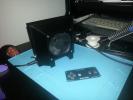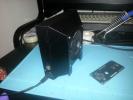-
Most Popular
Learning to make sprites
I was looking through the contents of the cassette that came with the ... Read More!Amstrad 3.5" Floppy drive - DSK to Disc
So you've got the floppy drive all powered and plugged in, but got no Amstrad CPC software on 3.5" d... Read More!Connecting a 3.5" floppy drive to an Amstrad 464 without modifying the drive or DDI-1
Quite some time ago I bought a DDI-1 interface to use with my amstrad 464's. Just the interface with... Read More!Yet more Amstrads added to the collection - ALT-386sx and PCW8256
If you haven't guessed already, I like my Amstrad computers. Purely because of nostalgia and curiosi... Read More!Schneider (Amstrad) CPC 664 surprise
As a collector of Amstrad machines, the holy grail to me is the Amstrad CPC 664. Only manufactured f... Read More!
Making a soldering station Extractor fan from an old PC case fanCreated on: 29-12-2020 By Gee |
Smoke and fumesEvery time I solder something, I end up getting annoyed with the fumes. It comes up towards my face and I am forever blowing it out the way in an attempt to not breathe it in. For quite some time now I've been wanting to modify an old 80mm case fan to take care of this problem for me. I ordered some Carbon filters for solder fume extractors (opens in a new Window) and they had been lying on desks and getting moved around whenever they got in the way. Never actually getting used for the purpose they were intended for. Finally building somethingWhilst doing a bit of organising, I noticed these filters still sitting in their packet. Unopened from when they were bought a YEAR previous (I have only just learned that it was a year!). Just recently having done some soldering to make a couple of Amstrad Controllers and a spliiter for someone, I remembered how much smoke I was getting from doing some light soldering at my desk. I opened up SolidWorks, started measuring out the 80mm fan dimensions and those of the filters. I didn't want to cut the filters down to any specific size, instead I tried to use the entire size of the filter in the hopes that it would help spread the fumes about and in turn be caught by said filter. The case was all drawn up and then sliced in the software for my 3d printer to print out. I had a couple of mishaps on the way that were ironed out, but it ended up coming out pretty much as I wanted. Two holes on the side for a power in connection and an on/off switch. PowerPowering the fan was an easy task. I'd solder the fan negative directly onto the negative of the female PSU connector and the positive would go to the on off switch, then to the same connector. I had a 12v PSU that I had found that was 200mA and perfect for the job as the fan only used 110mA. No point in getting anything beefier! However, when I tested the PSU it was showing 20v output. So I put that aside. I assume it is probably showing that just due to not having a load on it, but the fan wouldn't be much of a load to bring that down. So I sourced another 12v PSU. This time it was 1A. So quite a bit more than I need. Something isn't quite rightAnyway. I got everything soldered in and tested my new device. Nothing happened when I flicked the switch. Not even a twinge of the fan to suggest it wasn't getting enough power. I checked the voltage over the pins where the power was coming in. Nothing there. Turns out I had connected one of the wires to a part that is not connected (thankfully) and the positive wire onto the wrong pin. Remember boys and girls! check your wiring! So after resolving that stupid mistake and soldering things back together. I flicked the switch again, and we have lift off! Fan spins nicely. Will it draw enough air?Holding my hand over the front of the fan, i could feel the tiniest amount of air being sucked in towards the carbon filter. However, it didn't feel quite like enough. So I thought I'd test it out. What better to test it with that one of my own circuit boards that I need to put together anyway. Thankfully, the fumes went straight into the fan, and into the filter. I could also see that there was very minimal fumes coming out the back of the filter. I was expecting much more as the filter is so thin. Maybe I will add an extension onto this little device and put more filters in to try stop all of the fumes. For the moment, it helps keep the fumes from coming up into my face. So I'm counting that as a win! Safety firstWhilst soldering everything together, I was wondering how to put an inline fuse in. I didn't have anything to hand at the very moment in time, so it's currently unfused. Not a great idea for home made electrical equipment. I do plan on ordering some self resetting 200mA fuses and soldering them into the live line just after the switch. It would also be a good idea for me to cover this with some heat shrink once I have done so, just to stop anything from touching a live wire. If you would like to 3d print your own, I have attached the .stl file below. |
Associated files |

